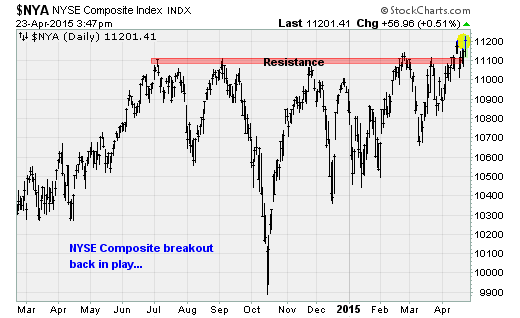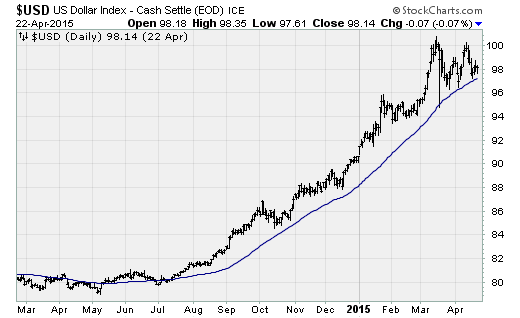Dollar weakness is giving stocks new strength
On Thursday, the Nasdaq Composite finally eclipsed its dot-com era closing high to set a new all-time nominal record of 5,056. While tech stocks were in the driver's seat, with Apple (AAPL) punching out of a multimonth consolidation on excitement over the retail launch of the Apple Watch (in-store sales start Friday), the market overall was looking strong.
Consider the NYSE Composite Index, which pushed to new record highs as equities, measured broadly, finally broke out of the long sideways consolidation range that started last July.
The catalyst wasn't earnings or economic data. Instead, credit the vagaries of the currency market as weakness in the U.S. dollar -- threatening a reversal of recent trends -- boosted a broad swath of assets. This included crude oil, copper, precious metals and the stocks connected to these goods. Energy, materials, steelmakers and mining names were all on the move.
As an example, the Market Vectors Steel ETF (SLX) put in its best performance since early February, rising 4.6 percent by day's end. Energy stocks, as represented by the Energy Select Sector SPDR (XLE), are pushing into territory not seen since November. Wholesale gasoline futures have climbed above $2 a gallon for the first time since November, up nearly 63 percent from the January low set of $1.23 a gallon.
To be sure, investors had many reasons to be apprehensive in recent months. Global growth has been uneven. The threat of the first interest rate hikes since 2006 from the Federal Reserve loomed large. Corporate earnings have been dented. And even job growth stalled in March.
But it looks like the Federal Reserve is getting cold feet concerning a June rate liftoff, pushing the rate hike timing back to September at the earliest or possibly in to 2016. That could be just what stocks need to soar again.
Over the last few weeks, Fed officials have been talking up their concerns about the consequences of the dollar's impressive rise over the past year -- including the drag on the foreign earnings of U.S. businesses and the dampening effect on inflation (which is below target) via the dollar's role in lower energy prices.
Boston Fed President Eric Rosengren admitted that a strong dollar makes it harder for the central bank to reach its employment and inflation goals. New York Fed President William Dudley blamed the dollar's rise on contributing to a slowdown in U.S. economic growth. And Atlanta Fed President Dennis Lockhart noted that the dollar's lofty valuation is bringing down net U.S. exports.
Including these concerns in the Fed's next policy announcement on April 29 could pull the U.S. dollar index down below its 50-day moving average -- a key metric chart watchers use to measure medium-term trends -- for the first time since last July.
In turn, this should amplify the market gains we saw on Thursday, boost assets that have been in the doghouse for months (like gold and silver) and put an end to the long sideways crawl in stocks.


